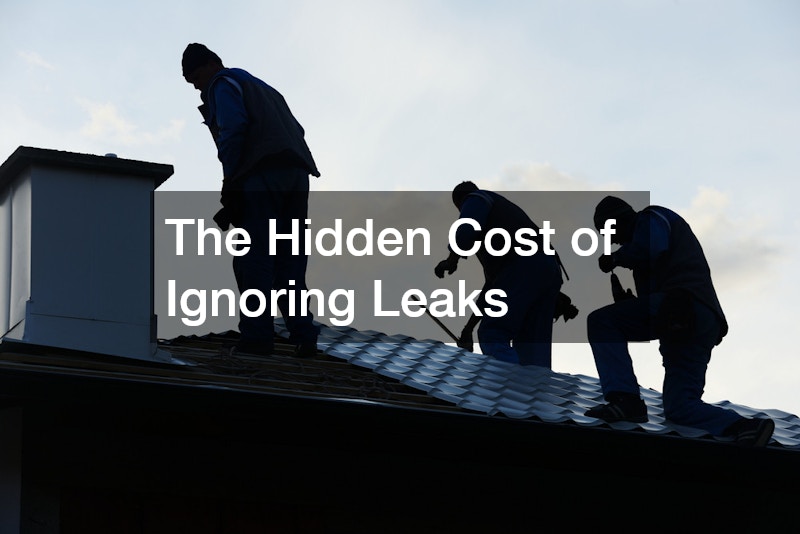Your roof is one of the most important parts of your home, yet it’s often the most overlooked—until something goes wrong. From minor leaks to major structural issues, knowing when your roof needs attention can save you from costly repairs and protect the integrity of your entire house. This guide is designed to help homeowners recognize the early warning signs, understand their options, and make informed decisions about repairs, maintenance, and replacement.
Recognizing the Signs: When Is It Time for a Roof Overhaul?
Your roof is one of the most critical components of your home’s structure, silently protecting everything beneath it from the elements. However, because it’s out of sight, it’s often out of mind—until a problem arises. Many homeowners struggle with knowing the right time to consider roof replacement services. Warning signs include cracked, curled, or missing shingles, frequent leaks, visible daylight through the attic, or sagging in the roofline. If your roof is more than 20 years old and showing signs of deterioration, it may be time to consider a complete replacement. Ignoring these signs can lead to costly interior damage, including mold growth and compromised insulation. Replacement services not only enhance your home’s safety and weather resistance but can also increase its overall value. A new roof can drastically improve curb appeal and energy efficiency, reducing your heating and cooling bills.
Living in an HOA? Know What Rules Apply

If you live in a community governed by a homeowners’ association, there’s an added layer of complexity when it comes to roof maintenance and replacement. HOA roof repair policies often dictate what types of materials can be used, the color of shingles, and even the timeline for repairs. Ignoring these guidelines can result in fines or delays in getting your project approved. Homeowners should start by reviewing their HOA bylaws and reaching out to the board before beginning any work. Some associations may require you to use specific contractors or follow uniformity standards to maintain neighborhood aesthetics. Even minor repairs can fall under HOA oversight. This is especially important if your roof has suffered storm damage or wear and tear. The association might share the responsibility for repairs, especially in condo developments or townhomes. In some cases, the HOA may even manage the repairs on your behalf, but homeowners still need to understand what’s covered.
Repairs vs. Replacements: The Value of Professional Help
For many homeowners, deciding between a minor patch job and a more extensive fix can be daunting. That’s where residential roof repair services come in. These professionals are trained to assess the damage and determine the most cost-effective and structurally sound solution. Sometimes, what looks like a small issue—such as a few missing shingles or a small leak—can indicate a deeper problem like underlayment deterioration or flashing failure. Skilled contractors can perform a comprehensive inspection, evaluating both surface and hidden issues that could compromise your home’s safety. They’ll also assess factors like weather exposure, ventilation, and previous repairs to gauge the roof’s overall health. Residential roof repair services offer customized solutions, from spot repairs to extensive reinforcement, based on the needs of your home. Investing in expert advice not only extends the lifespan of your roof but also ensures that repairs are up to code and backed by warranty.
Choosing the Right Help: Why Local Matters

When your roof needs attention, it can be tempting to go with the first contractor that pops up online or the lowest quote available. However, hiring a local roofer has clear advantages. Local contractors are familiar with regional weather patterns, local building codes, and permit processes. This means they are better equipped to recommend appropriate materials and methods suited to your environment. A local roofer also has a vested interest in maintaining their reputation within the community, which typically results in better customer service and accountability. Unlike out-of-town or national contractors, local professionals are easier to reach if something goes wrong after installation or repair. Moreover, many local roofers build long-term relationships with suppliers, which could translate into savings for you and faster access to materials. A well-established local business is also more likely to carry the appropriate licenses, insurance, and references. This provides an additional layer of protection and peace of mind. Before hiring, ask neighbors or check community forums for recommendations, and always verify credentials. Ultimately, hiring a trusted local roofer ensures that your project is not only handled professionally but also supported by someone who understands your area’s unique demands.
More Than Just Shingles: How Roofing Connects
While roofing may be your primary concern, it’s important not to overlook your home’s siding. The condition of your roof often affects how well your roof can perform. Both systems work together to protect your home from moisture intrusion, wind damage, and temperature fluctuations. When your roof has issues like poor drainage or missing flashing, it can allow water to run down. Likewise, damaged or warped siding can allow water to creep up into the roofline. Homeowners tackling projects should assess this at the same time, especially if both are aging. If your home has experienced storms or hail, both may require repair or replacement. Some contractors even offer bundled services for roofing and siding updates, allowing for cost and time savings. Siding also plays a crucial role in insulation, which complements energy-efficient roofing. By addressing both elements in a single renovation, you enhance your home’s protection and appearance. A coordinated approach also ensures color and material harmony for better curb appeal. Whether you’re replacing or just making minor repairs, always consider its relationship with your roof to get the most from your investment.
Planning Your Budget: What Goes Into an Estimate

One of the most critical steps in any roofing project is getting an accurate estimate. This estimate helps homeowners budget appropriately, avoid hidden costs, and determine the scope of work. A detailed roofing estimate should include labor, materials, debris removal, permit fees, and warranty coverage. It should also account for the type of material, the size of your roof, the pitch, and any structural concerns like rot or sagging areas. If you’re dealing with storm damage or other insurance-related repairs, the estimate may need to be submitted for claim approval, so accuracy is key. Be wary of estimates that are overly vague or unusually low, as they can lead to costly surprises later. Reputable contractors will typically offer a free or low-cost estimate after a thorough inspection. During the process, ask questions about timelines, payment schedules, and contingency planning for unexpected issues. It’s also helpful to request multiple quotes so you can compare pricing, materials, and services. Remember that the cheapest estimate isn’t always the best—look for value, reputation, and transparency. A clear and comprehensive estimate is the foundation for a successful project, helping you plan confidently and avoid unnecessary stress.
After the Storm: What to Do When Damage Strikes
Severe weather can wreak havoc on your home in just minutes, leaving you to deal with the aftermath. That’s why it’s vital to act quickly and methodically after a storm. The first step in storm damage repair is to assess the visible damage from a safe distance. Look for missing shingles, sagging areas, punctures, and debris on the roof. If safe to do so, check your attic for water intrusion or wet insulation. Taking photos and documenting damage is critical for insurance claims. Next, contact a qualified contractor who specializes in storm damage repair to conduct a full inspection and provide recommendations. Many contractors offer emergency tarping to prevent further damage while repairs are scheduled. Time is of the essence—waiting too long can void insurance claims or result in structural damage that worsens. Some damage may not be immediately visible, especially to flashing or underlayment, so professional assessment is crucial. Also, coordinate with your insurance provider as soon as possible to understand what documentation they require. Storm damage repair goes beyond patching holes; it’s about restoring your home’s integrity. Prioritize licensed contractors with a track record in post-storm recovery to ensure proper handling of every repair phase.
The Hidden Cost of Ignoring Leaks

Among the most common signs that your roof needs attention are leaks. What may start as a small drip can quickly evolve into major structural damage. Water intrusion compromises not only the integrity of your roofing system but also the insulation, framing, drywall, and electrical systems inside your home. Often, leaks go unnoticed until they cause visible stains or mold growth, by which time the damage is extensive. Regular inspections and prompt repairs are essential to avoid these costly consequences. In some cases, the source of a leak may not be where the water appears inside your home. Water can travel along beams and surfaces before making itself known. That’s why professional leak detection is so important. A contractor can trace the source and recommend targeted fixes. It’s also crucial to inspect your roof after heavy storms, snow, or ice events, which often cause unnoticed damage. Homeowners should treat leaky roofs as urgent repair issues. Left unaddressed, they compromise your home’s comfort, safety, and value. Preventive maintenance and timely intervention are the best defenses. Even small roof leaks should never be ignored. They are a clear signal that your roof is failing and needs immediate evaluation.
How Modern Materials Make a Difference
Technology in the industry has advanced significantly, offering homeowners more options than ever before. One of the most durable and long-lasting solutions is metal. While often more expensive upfront than traditional shingles, metal offers unmatched longevity, often lasting 40-70 years with minimal maintenance. A reliable metal roofing company can walk you through various options, including steel, aluminum, and copper finishes, each with unique benefits and visual appeal. Metal roofs are highly resistant to fire, wind, and pests, making them ideal for areas prone to extreme weather. They also reflect solar heat, which can reduce cooling costs during summer. Additionally, most metal materials are recyclable, making them a more sustainable choice. When installed properly, they create a watertight barrier that virtually eliminates the risk of leaks. While some homeowners worry about noise, modern insulation techniques largely solve this issue. To get the best results, it’s essential to work with a certified metal roof company that can ensure precision installation and offer strong warranty coverage. If you’re considering a long-term solution that adds value, style, and performance to your home, metal roofing should be at the top of your list.
Sealing the Deal: Why the Right Materials Matter
When it comes to long-term roof performance, few things are as important as proper sealants. These materials are used to create waterproof barriers around vents, skylights, chimneys, and flashing—areas most vulnerable to leaks. Without effective sealing, even a new roof can suffer from premature wear and moisture intrusion. The right sealant helps prevent the damaging effects of water, UV rays, and fluctuating temperatures. Over time, however, they can degrade, crack, or separate due to environmental exposure. That’s why periodic inspection and reapplication are crucial. Not all are created equal; some are designed for specific materials or climate conditions. For example, silicone-based sealants offer flexibility and longevity, while polyurethane bonds well to wood and metal. A qualified contractor will know which products to use for your specific system. They’re especially important for older roofs or those with complex architectural features. Proper application ensures all seams and joints are protected, reducing the likelihood of leaks and extending the lifespan of the entire roof. During any roof inspection or maintenance service, always ask your contractor to check the condition of existing sealants. It’s a simple step that can save you thousands in future repair costs.
Homeownership comes with its fair share of responsibilities, and roofing is one of the most critical to get right. From replacing aged materials to repairing damage after a storm, understanding the signs of roof deterioration and acting quickly is key. Being informed empowers you to make smarter decisions—whether that’s comparing an estimate, evaluating, or choosing locally. Don’t wait for water stains or skyrocketing utility bills to take action. Preventive maintenance, periodic inspections, and working with reputable professionals all contribute to a roof that protects your investment and your family for decades.


